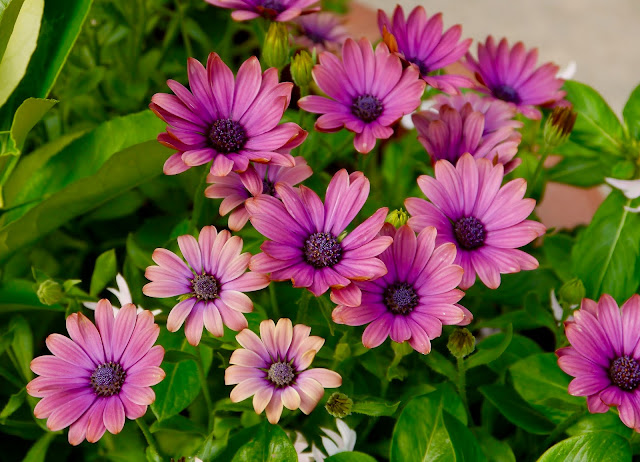Perfume ...
"heralds your arrival and
prolongs your departure."
Coco Chanel
Stop and Smell the Flowers
it is an invitation to the new "Making Scents" exhibition at the Arboretum in Asheville.
This exhibition shows the history of perfumes.
Presents also the processes of creating fragrances - starting from traditional flower harvesting methods and their extraction, to a chemical combination of synthetic fragrances.
History of Perfume
A few important and interesting events in the history of perfumes
1850 BC - the earliest perfume of the world was created on the Mediterranean island of Cyprus.
It was a mixture of anise, pine, coriander, bergamot, almond and parsley extracts with olive oil;
1500-1400 BC - Egyptians used perfume Kyphi, a mixture of 16 ingredients, including honey, myrrh, juniper berries and wine;
1100 - in Salerno, Italy the process for distilling alcohol was discover, which was used in the time for pharmaceutical and medical purposes;
1370 - “The Queen of Hungary Water” is the name of the first alcohol-based perfume made in Europe for Elisabeth of Poland (1305 – 1380), Queen of Hungary and sister of Casimir the Great of Poland. It is said that this perfume was made to be a cure for rheumatism or gout which the queen suffered in her old age or as a rejuvenation treatment for this 70-years old queen which made 25-year old grad-duke of Lithuania propose her. Water was used as a face and hand wash, as a rubbing alcohol or consumed.
1715-1744 - during King Louis XV's reign perfumes were so much in demand that etiquette required the use of a different fragrance each day - so Versailles was a real "perfumed court".
This not surprise, that King's wife Marie Leszczynska (the Polish princess), preferred to be in her private apartments, spending time with a small group of close friends.
Make your own fragrance
There are two computerized stations which allow visitors create their own fragrance card by selecting different fragrances.
Depending on the dominant character of the ingredients, there are seven classes of perfume:
oriental, leather, chypre, floral, citrus, fern, woody.
Synthetic fragrances
First perfume based on synthetic was created in 1889 by Guerlain - the same year the Eiffel Tower was built.
Extracting Fragrance from Nature
Grasse - a town on the French Riviera with long-established perfume industry; by the 17th century, Grasse was the capital of perfume production with its ideal climate for cultivation some flowers used to create fragrances.Eugène Fuchs opened his own perfumery, Maison Fragonard, in 1926 in Grasse. It is one of the oldest perfumeries in the city. Its name is a tribute to the famous eighteenth-century painter Jean-Honoré Fragonard, who was born there.
 |
| Picker harvests rose de mai flowers in Grasse, France |
Edmond Roudnitska (of Polish origin) - a big name in the perfume industry
Edmond Roudnitska - in English
Edmond Roudnitska - in Polish
Scent-Seeking stations.
The part of this exhibit is also in the gardens where are 10 different Scent-Seeking stations.
The part of this exhibit is also in the gardens where are 10 different Scent-Seeking stations.
Each stations present one fragrance and its history.
Below there are two stations: Emperor and Artist.
Scent Seeker: Emperor
Napoleon Bonaparte loved fragrance. He used several expensive bottles of cologne every day.
Napoleon liked to bathe in 4711 the world's first eau de cologne.
Napoleon liked to bathe in 4711 the world's first eau de cologne.
Scent Seeker: Artist
This station presents fashion designer and perfumer Elsa Schiaparelli. She designed a bottle of her perfume Shocking in the shape of the curvy figure of Mae West, an old-time movie star.
She collaborated also with an artist Salvatore Dali on the bottle of Le Roy of Soleil perfume.
A Bottle of Art
The most amazing part of the exhibition is the "Perfume Palace" - collection of 200 perfume bottles.
Some of them come from the times of ancient Greece and Rome, others are glittering works of great art glass makers of 19th century art and designers such as Lalique and Tiffany.
This part of exhibition have been created thanks to a partnership with the
International Perfume Bottle Association (IPBA).
Some members of this organization and volunteers also contributed bottles from their own collections.
The most amazing part of the exhibition is the "Perfume Palace" - collection of 200 perfume bottles.
Some of them come from the times of ancient Greece and Rome, others are glittering works of great art glass makers of 19th century art and designers such as Lalique and Tiffany.
This part of exhibition have been created thanks to a partnership with the
International Perfume Bottle Association (IPBA).
Some members of this organization and volunteers also contributed bottles from their own collections.

Stop and Smell the Flowers
- again, this time in the Arboretum gardens. Many summer flowers are blooming now!
Even though I don't use perfume I have found this exhibition very interesting and educating.



















































